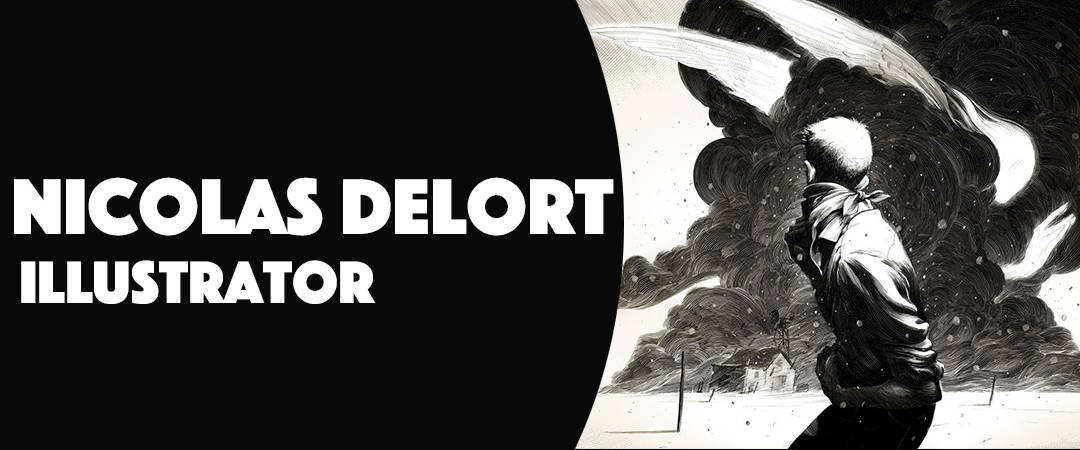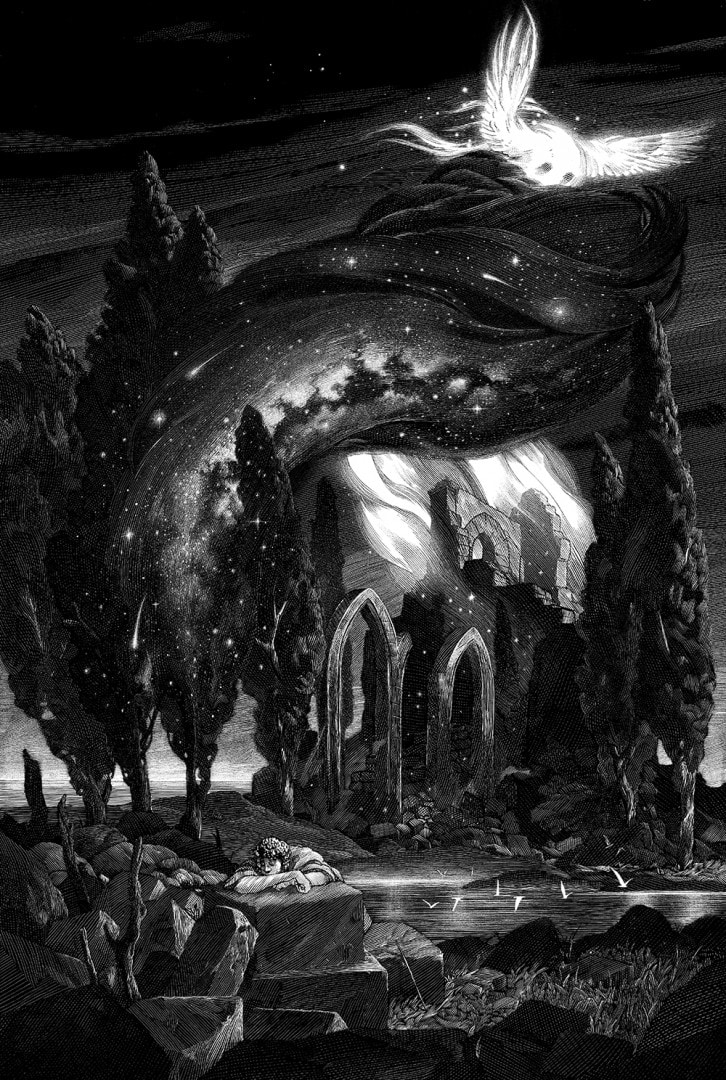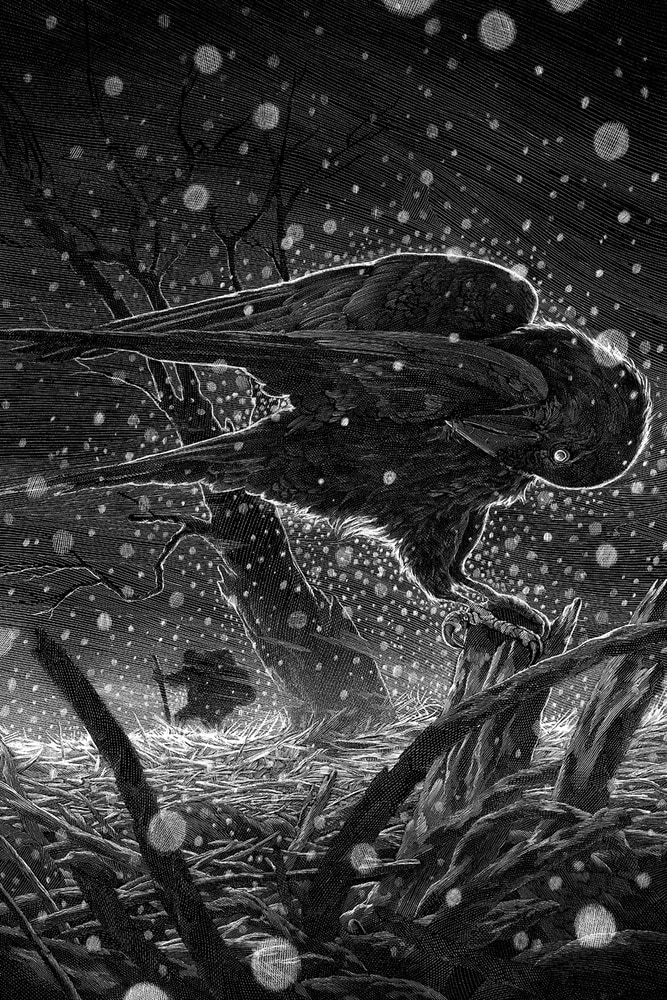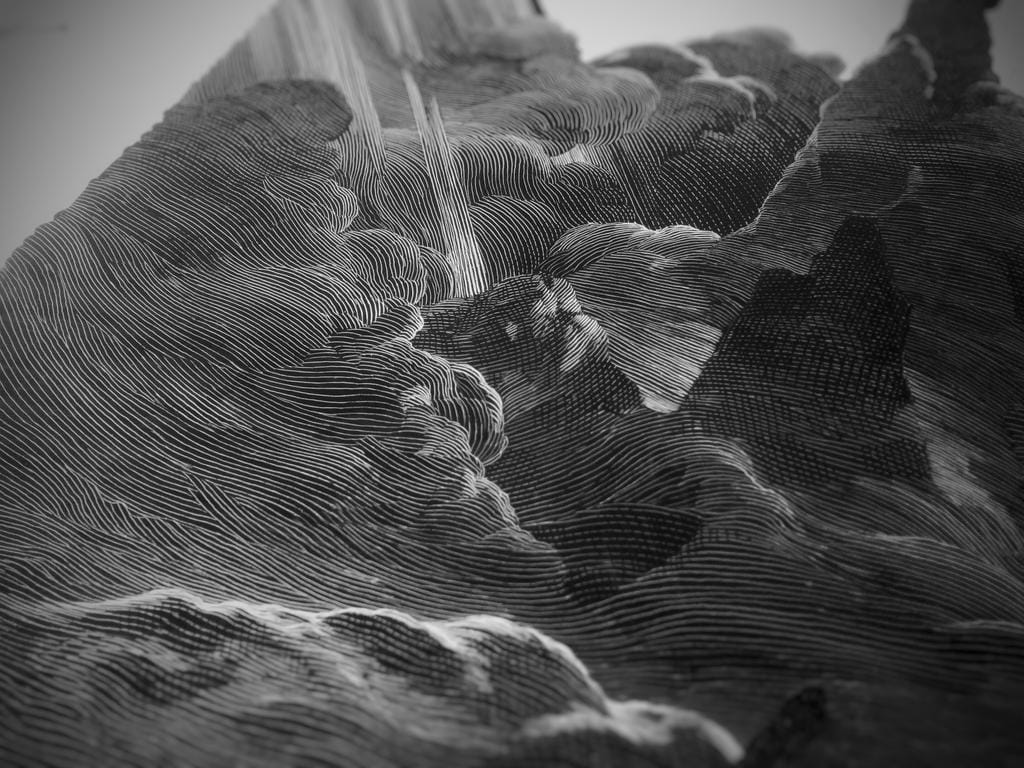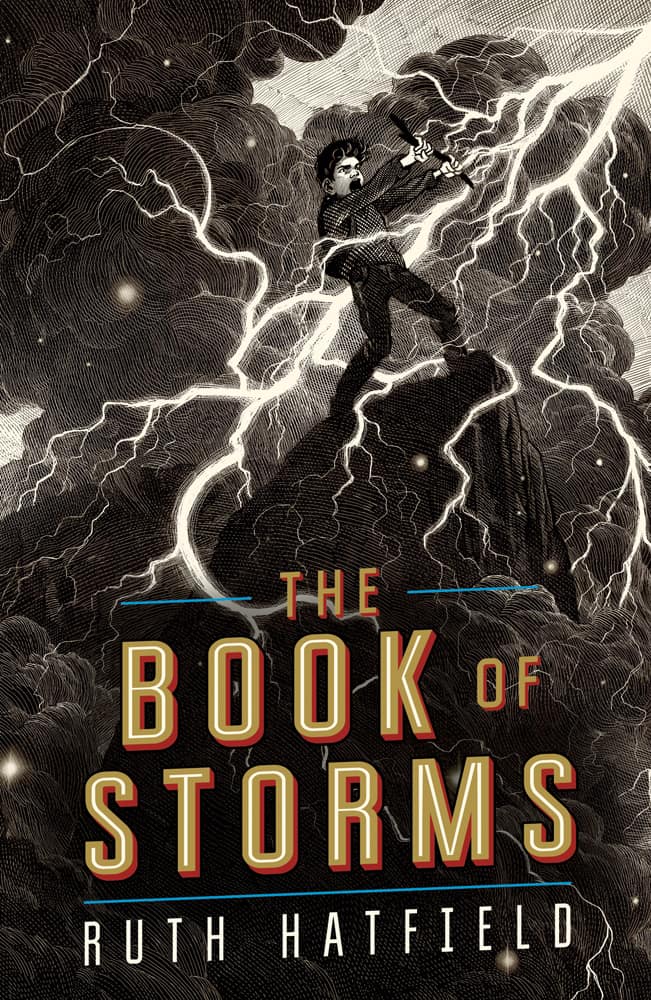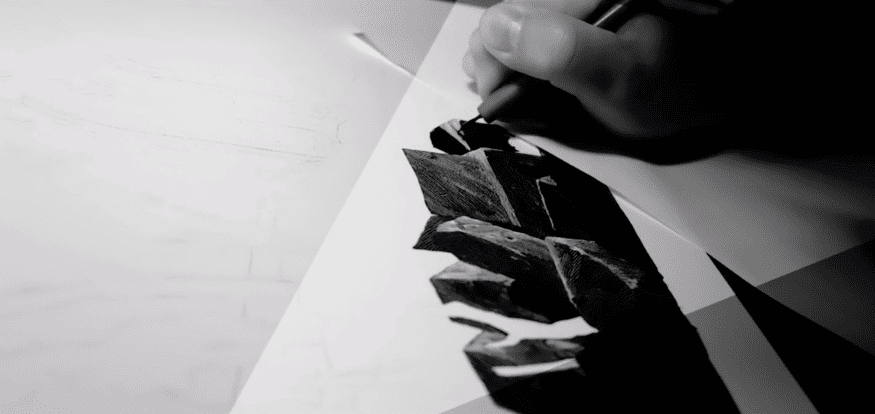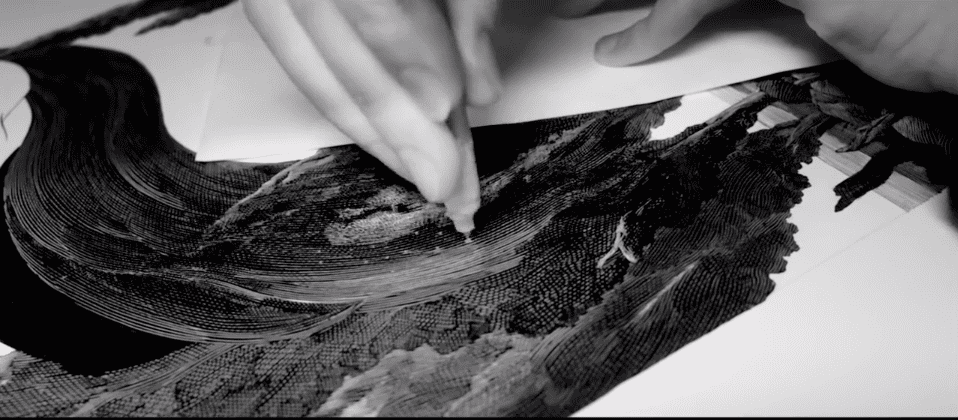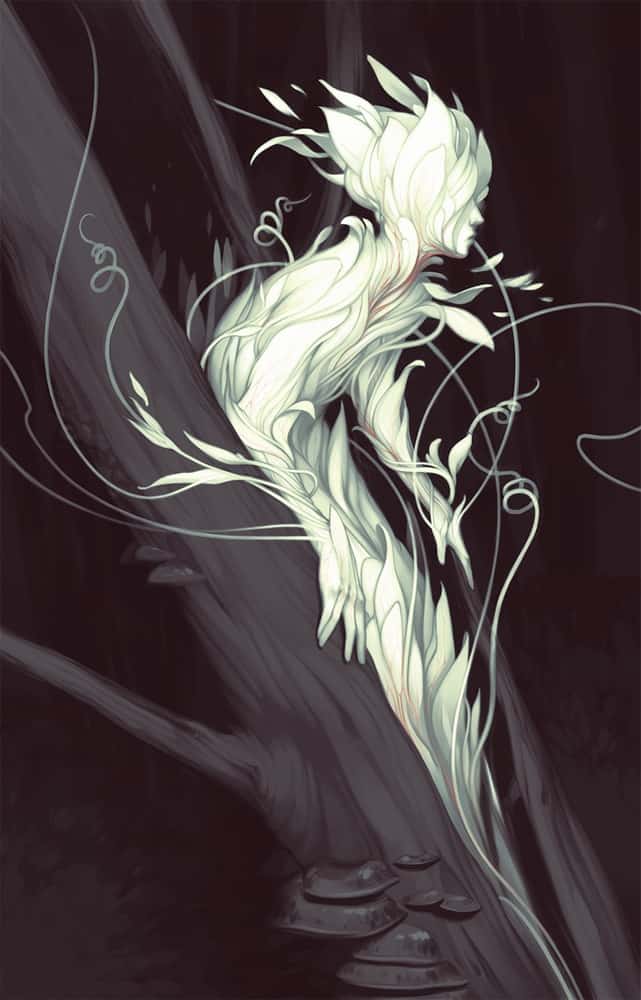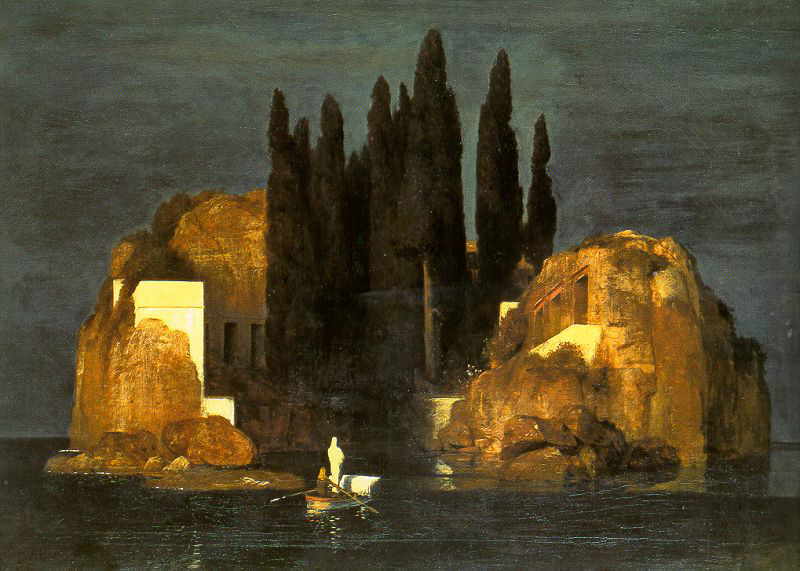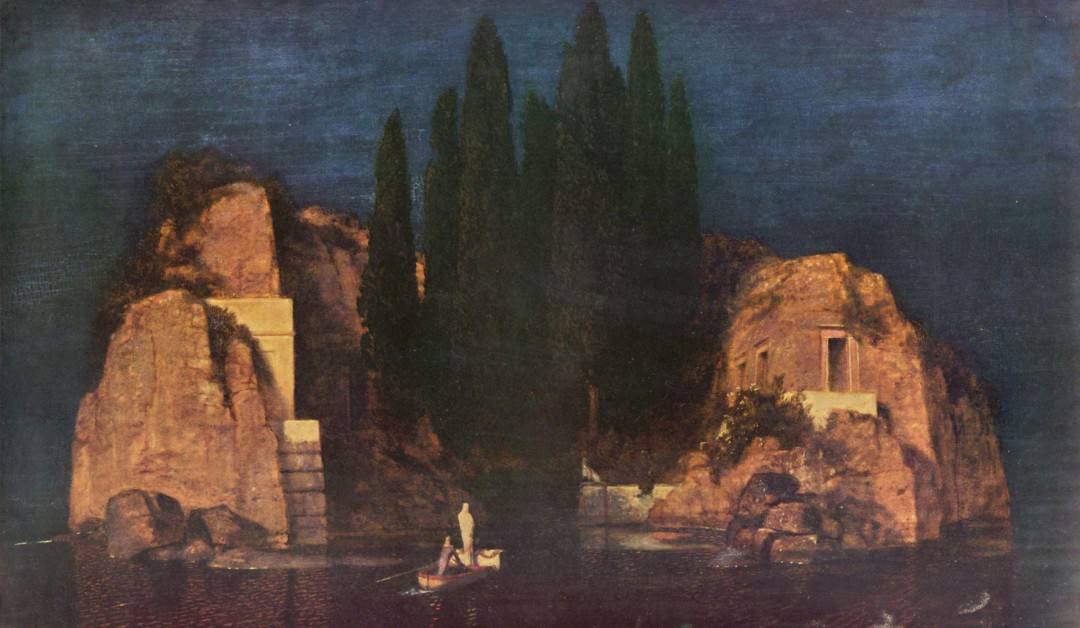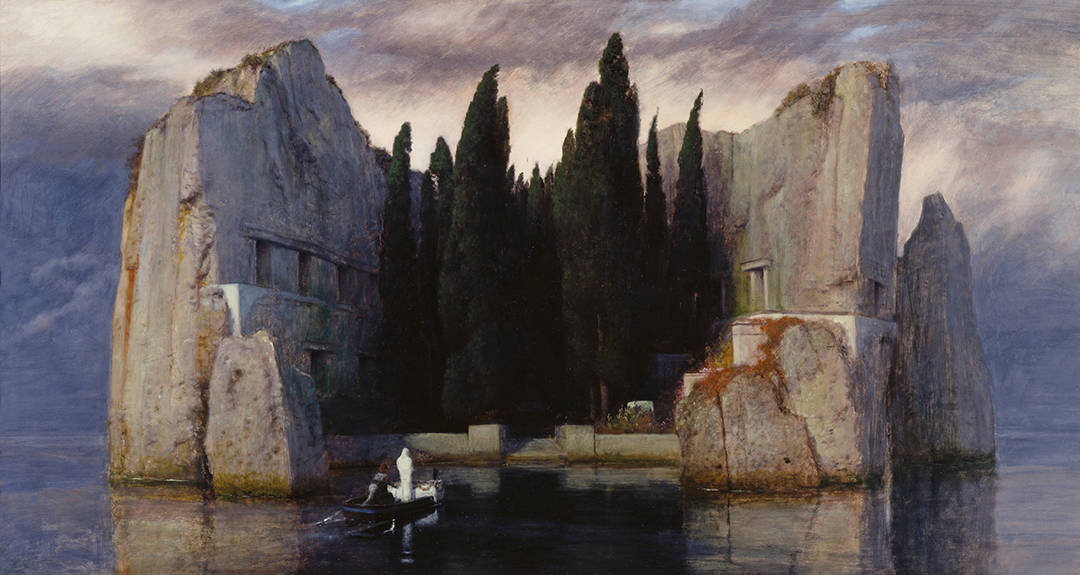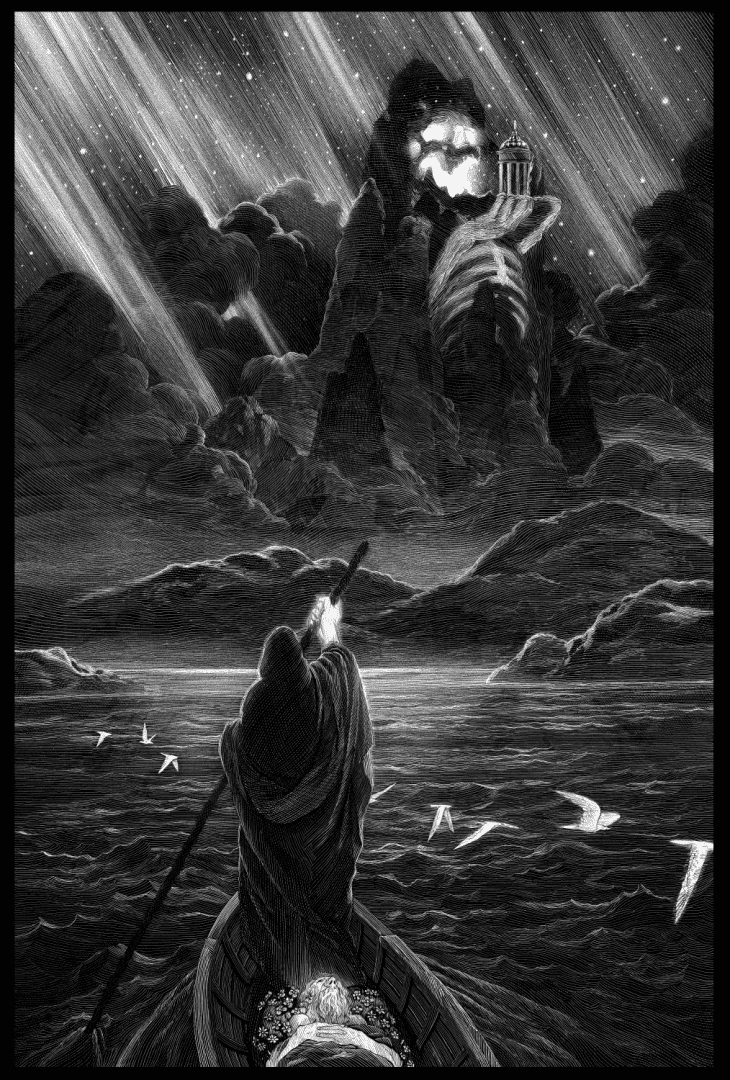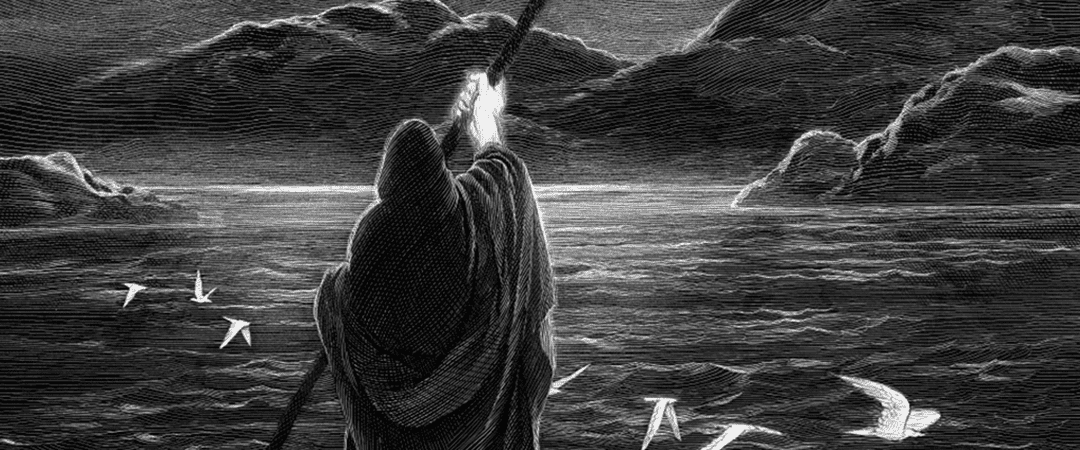
In 1828 Franz Schubert wrote a song cycle based on the poems of Willhelm Müller titled ‘Winterreise.’ The music, ‘Winter Journey‘ in English, was composed while Schubert was dying of syphilis. The first line of Müller’s work reads, ‘A stranger I arrived; a stranger I depart.’ Knowing his death was soon to come, perhaps it was with this line in his heart that Schubert began the task of creating one of his greatest works.
In ‘Winterreise,’ a dismissed lover travels alone through a harsh winter. Each poem chronicles the lover’s heartache. For his illustration inspired by Schubert’s ‘Winterreise’ France based artist Nicolas Delort took to the song titled ‘Die Krähe’ (‘The Crow’) which finds the lover being followed by a crow, waiting for him to fall dead in the winter snow so the bird can eat his remains. Müller’s narrator speaks, ‘It won’t be much longer now. Crow, show me constancy unto death!’ Delort brought the crow itself to the foreground of the moment, waiting for the traveler to fall. To give up.
‘Winterreise‘ is only one of the illustrations in Delort’s ‘Classical Series‘ of art prints, the first being his take of J.S. Bach’s ‘Goldberg Variations‘ and the upcoming and final release, Sergei Rachmaninov’s ‘Isle of the Dead.’ Our modern ears are no longer trained to pick up on the subtle shifts of classical musical and its orchestral interplay — there are no hooks for us to grasp easily. No sing-song chorus or enigmatic front man, but there is an important layer of history to Delort’s choices. Bach’s ‘Goldberg Variations‘ written for the sleepless Russian ambassador Count Kaiserling has become a hallmark of the variation form, and Rachmaninov’s ‘Isle of the Dead‘ acts as the score to Arnold Bröcklin’s painting of the same name; a composition he repainted five different times over the course of his life.
Each of the three illustrations in Delort’s ‘Classical Series‘ act as a visual aid, giving the audience an education in history and the timeless grace of music that rests in the spine of our contemporary world.
ETDC: Your ‘Classical Series’ prints are gig posters in a way, or at least a bit similar – visualizing the tone of a specific musician and piece of music. Do you feel a closer connection to classical music than contemporary?
ND: In a way, yes. I listen to all sorts of stuff, but my preference goes to atmospheric orchestral or instrumental music. It’s not limited to classical really, as I listen to a lot of video game or movie scores too. I’ve been playing instruments for as long as I can remember, picking up a new one every other year (only to let it collect dust when I find a new one) and I used to play in an orchestra in high school. I really miss it, but I just don’t have time for it anymore, so I make up for it by listening to the stuff I’d want to play. I listen to different interpretations, compare them and then learn portions I like on whatever instrument I happen to be interested in at the moment. It’s a nice release after sitting for long hours quietly making tiny, steady lines.
I listen to a lot of my mainstream pop too but I’m really not knowledgeable about contemporary music and bands in general, so I just don’t know a lot of things I like. I’m sure if I took the time to listen to bands and dig a little deeper, I’d find stuff I like.
Classical music has an interesting arrangement – the music can exist, hundreds of years old, and with each passing year a different conductor and a new set of musicians will interpret what’s been written down and performed before. With your ‘Classical Series,’ you joined in on that history, that ongoing conversation. What attracted you to join in on the conversation of these specific pieces?
I chose those pieces mostly because they were my first ‘introductions’ to these three artists and I felt there was a lot to do with them from an illustrative point of view. They are very visual pieces in a sense. Also, I felt they were well known enough that people could relate to them. I had some more obscure pieces in mind at first, but I thought the series was already a risky concept enough so in the end, I went for pieces that were a bit more famous.
There are countless recordings of Bach’s ‘Goldberg Variations’ and Schubert’s ‘Winterreise.’ With ‘Winterreise’ being a vocal work, you get quite a lot of variations in the singers, so based on your preference in singer some are good, some are bad. Are there specific recordings of these pieces that you responded to? What version were the prints inspired by?
For ‘The Goldberg Variations,’ I really love the 1969 recording by Wilhelm Kempff. It’s one of the few (to my knowledge) recordings in which the pianist foregoes the ornaments and it really brings out the melodies in their simplest form. We’re not used to hearing the variations performed that way, so they sound really whimsical and ‘pure’, for lack of a better word.

For ‘Winterreise,’ one of my preferred recordings is the 1940 recording by Lötte Lehmann. She brings out an air of melancholy and mystery that other singers don’t, in my opinion. The scratchiness of the old recording adds a lot too in this case. It’s mostly why I based my ‘Winterreise’ print more specifically on this one song, ‘Die Krähe’ (‘The Crow’). I felt like it was the most representative of the whole cycle.

For ‘Isle of the Dead,’ it’s a little harder to pick out a favorite, but one of the first recordings is conducted by Rachmaninov himself, so it’s very interesting to hear what it would’ve sounded like in his mind.

Working in a series allowed you to explore the music you love in a very direct and personal way. Was this your first attempt at a series of work? Is it a process you’ll be taking on again?
It was the first time doing something like this indeed! Definitely something I would do again, but to be honest, I do it more than I think really, mostly subconsciously.
The music I listen to seeps into my work in subtle ways and most of my pieces end up being very ‘musical’ even if it’s not the initial intention.
Is it more of a challenge to create an illustration inspired by music or a book cover rather than a film or something where you have a visual as well as a narrative reference point?
In a way, yes, having a reference point, whether visual or narrative, can be easier. It gives you a starting point and something to build upon. On the flip side, it can also sometimes be a challenge to stick to those reference points, especially when it’s based on material that’s out of your comfort zone.
Some movies feel like a natural fit, others I have to dig a little deeper to find an angle I’m comfortable with. With book covers it’s yet another set of challenges: you have to convey what the book is about without revealing too much about the plot and make people want to pick it up. I wouldn’t say one is harder than the other, it’s just all very different ways to approach illustration.
Will the series be ongoing, or are these three pieces the start and finish of the project?
For now, it’s only these three. I would love to do more, but it depends on a lot of factors!
What would it take to get you to continue the ‘Classical Series’? Is it time? Money? Do you have ideas on what would come next?
Time mostly, I’m balancing a lot of different plates at the moment and rarely have time to conceptualize, let alone execute, more personal pieces like this. But as long as BDP is up for letting me do more, I’ll do my best to continue the series!
Next would be the Allegretto of Beethoven’s 7th symphony. It’s very famous and it’s very easy to imagine a story around it. I would also love to do a piece based on the 24th Fugue from Shostakovitch’s 24 preludes and fugues, but it’s very abstract music and trying to distill it down to a single image wouldn’t be easy at all.
Does your scratchboard technique hold you back from any spontaneity in your work? How tight are the compositions before you start a piece?
When I’m working for strongly art-directed client work, I make sure my rough is as tight as it can be before starting on the scratchboard, because it’s much harder to make major changes then. When I’m working on more personal work, or work that can be a bit looser, I tend to improvise a lot on the scratchboard.
I’ll have my composition nailed down, but some areas will just be blocks with like ‘here be stormy clouds’ or ‘here be trees’ and then I just make it up as I go. So while it may seem like a very rigid technique, there is still a lot of room for spontaneity. The direction of the lines, for instance, that’s something I entirely make up on the spot, and I generally use it to reinforce movement or to bring together a focus point.
Did you approach Black Dragon Press with the concept, or were they looking for someone to take on a music-based series?
James (Park of Black Dragon Press) offered to let me do a more personal series alongside my other releases for Black Dragon Press and I suggested the music series idea. I’m very grateful that James is open to exploring themes outside the pop-culture canon.
You’ve acted as art director for a handful of prints for Black Dragon. Is that a new role for you? Do you enjoy being on the other side of things, guiding the work from the client-side?
It is my first-time art directing and so far it’s been really fun. There’s a lot of emailing involved, which is less fun, but getting to commission and collaborate with some of my favorite artists and seeing the piece from start to finish is very rewarding. I try to give the artists I hire as much freedom as possible and so far they’ve done nothing but spectacular work.
Helping others build an illustration can also be very formative for my own work, as I see mistakes in others’ work I don’t necessarily see in my own and it all helps seeing things from a different angle.
Your third piece in the series is Sergei Rachmaninoff’s ‘Isle of The Dead,’ a symphonic piece based on a painting by artist Arnold Böcklin. Are you taking inspiration from the music itself or also the painting? There is quite a bit going on in Schubert’s life during his creation of ‘Winterreise,’ plus a storied history after its completion – does all of that affect your own creation process?
Making an illustration based on a musical composition based on a painting was probably not a very smart choice in retrospect, especially since Böcklin‘s piece is so famous. But it was a fun challenge nonetheless.
I tried to set aside the painting in my mind and focus on the atmosphere brought on by the piece. The poem is very picturesque in and of itself. Rachmaninov used a 5/8 time signature to suggest the ferryman slowly rowing his boat towards the island. The first section of the piece is very mysterious and very slowly builds up to the ‘reveal.’ If you listen to the aforementioned recording, around the 6:00 the build-up intensifies and you can feel we’re getting closer to the island – it builds up and builds up and around 6:50, I pictured the clouds pulling apart to reveal the ominous island. I wanted the piece to have an otherworldly, supernatural look, so I played that aspect up in the sky.
For ‘Winterreise’ it was a bit easier. The cycle has a clear narrative to it, so there was a bit less ‘interpretation’ to do on my side. Like I said earlier, I was mostly inspired by the song ‘Die Krähe,’ but I threw in a subtle reference to the overall story, with the discarded engagement ring in the foreground (yes it’s there!).

‘Isle of The Dead’ (Fourth Version) 1884 by Arnold Böcklin | Black & White photograph. Original painting destroyed in a bomb attack during World War II.
It’s interesting to look at someone like Arnold Böcklin and his ‘Isle of the Dead’ painting, something he painted multiple times, each one a success in both terms of expanding his concept and monetarily. Are there any of your works that you’d want to revisit, following Böcklin’s footsteps? Would something like that fly with today’s collector?
Böcklin is notorious for making several iterations of many of his paintings (‘Villa by the Sea’ had no less than 5 or 6 versions) and that’s something that I strongly relate to. When I’m working on personal work, I always do dozens of different versions before I stop the insanity and settle on one to take to final. T
here’s quite a few pieces I’ve finished that I’d love to revisit now that my technique and style have evolved, but I hold it off because I’m always afraid the ‘remake’ won’t have the spontaneity of the original. I think collectors wouldn’t mind as long as the remake brings something new, whether it’s an evolution in style or a new aspect to the story.. if it’s a shot-for-shot rehash, I don’t think there’d be much point to it.
At one point our ‘classical’ music was just music to the society of its time. It’s sad to see it fall out of favor, where local symphonies, ballet, and opera companies are struggling or closing altogether. Was there any concern on your part in doing illustrations based on a style of music that isn’t as much in mainstream as it used to be?
Do you hope these prints will inspire the audience to seek out the music they are based on or is that not a thought you had? How much of a concern is the audience and their expectations?
I tried not to think of the audience in terms of sales and stuff like that but more in terms of whether they’d like the illustrations or not. If you like a piece, it shouldn’t really matter that much what it’s based on, whether it’s your favorite movie or something completely obscure, at least that’s how I see things.
If my pieces inspire some people to look into the music they were inspired by, that’s awesome, but I understand that classical music is not everyone’s cup of tea, so I was more concerned about making images people can relate to without knowing the source material.
